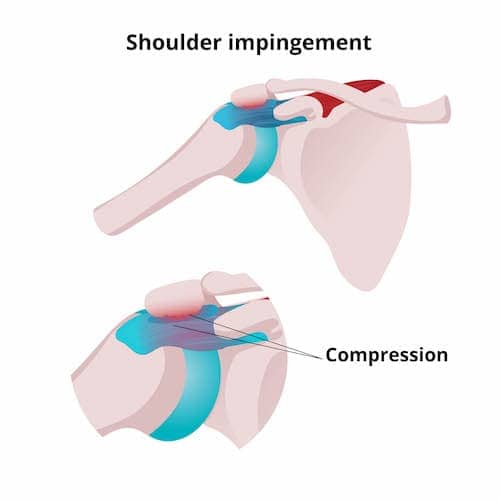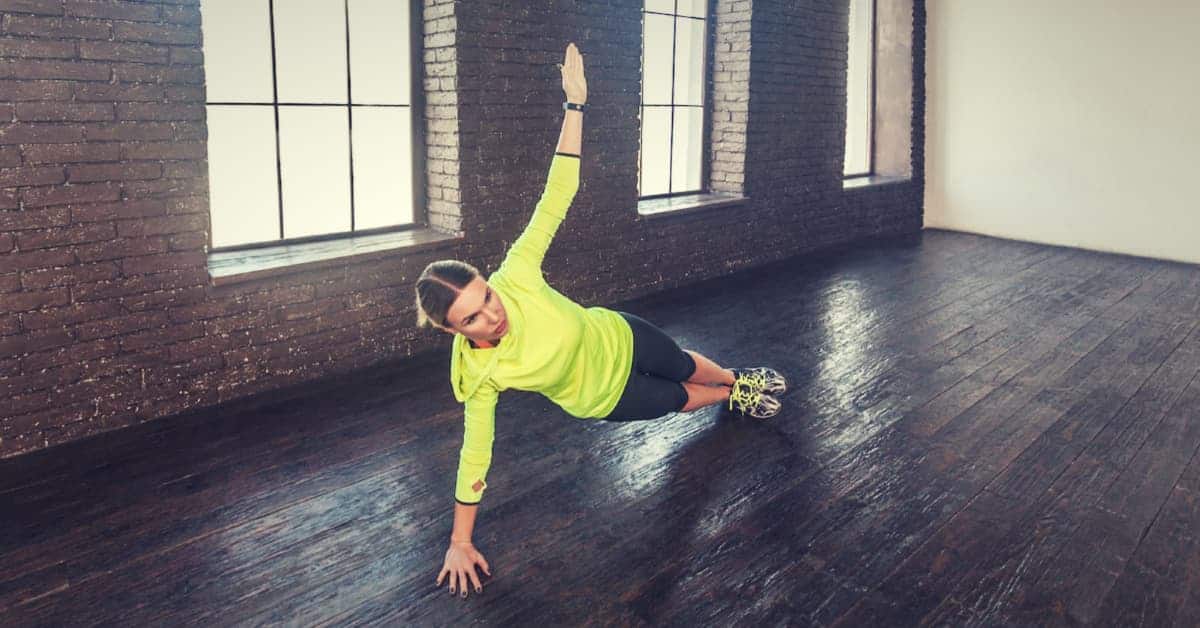Poor posture has become a common, often overlooked health issue in our modern era. This may be due to long hours spent at a computer, frequently bending over our smartphones, or simply the stresses of everyday life. Over time, these habits can lead to suboptimal shoulder positioning and even escalate into a discomforting condition known as shoulder impingement.
This post offers self-massage techniques, targeted stretches, and strengthening exercises designed specifically to address shoulder impingement. Let’s get you on the path towards a healthier shoulder.
I. Understanding Shoulder Impingement
Shoulder impingement, also known as impingement syndrome or rotator cuff impingement, is a common condition affecting the shoulder joint. It occurs when the tendons of the rotator cuff muscles become compressed or “impinged” between the bones of the shoulder joint, specifically between the head of the humerus (upper arm bone) and a part of the scapula known as the acromion.

As you raise your arm, the rotator cuff tendons and the adjacent lubricating sac, or bursa, glide smoothly under this arch. However, narrowing the space due to factors like inflammation or bone spurs can cause a pinching effect on these structures, leading to shoulder impingement. This causes discomfort and limits the shoulder’s full range of motion [1].
The symptoms of shoulder impingement include pain while lifting the arm, difficulty reaching up behind the back, decreased strength of the shoulder muscles, and a persistent dull ache in the shoulder [2]. These symptoms can vary from mild to severe, depending on the extent of the impingement and the individual’s pain tolerance.
II. Causes of Shoulder Impingement
Generally, two main factors contribute to this condition: Poor posture and other common factors like repetitive lifting or specific sports activities.
A. Poor posture
The primary culprits of shoulder impingement often include muscle imbalances, typically arising from poor posture, a common issue in our increasingly sedentary lives [3].
As we spend more time hunched over screens, our shoulders tend to round forward in an unhealthy posture known as internal shoulder rotation. With our arms internally rotated for long periods, certain muscles — particularly the pectorals and the lats — become overly tight.
Conversely, the muscles at the back of our shoulders and upper back — including the rhomboids and trapezius — become overly elongated and weak. This muscle imbalance can lead to shoulder impingement, causing discomfort and limited mobility [4].
B. Other causes
In addition to muscle imbalances, other factors can contribute to shoulder impingement. Repetitive overhead movements, such as those often performed in swimming, tennis, or certain occupations like painting or construction, can put stress on the shoulder joint, leading to impingement.
Likewise, ageing, acute injuries or trauma to the shoulder can also lead to this condition.
III. Self-diagnostic Tests for Shoulder Impingement
If you’re experiencing shoulder discomfort and suspect shoulder impingement, here are three simple self-diagnostic tests you can perform. Remember, these tests are not a replacement for professional medical advice, but they can tell you whether you should seek further help.
- Cross-body Reach Test: Place one hand on your opposing shoulder, then raise your elbow directly upwards. If it’s painful, it could be indicative of shoulder impingement.
- Thumbs-down Lift Test: Extend your arms out in front of you with your thumbs pointing downwards, like giving a double thumbs-down. Put your two palms against each other and then raise your arms up and over your head. Pain during this movement could signal shoulder impingement.
- Overhead Reach: Simply raise your arms above your head. If this action causes pain, shoulder impingement may be the cause.
If you’re still unsure after doing these tests, consult a physician, who can help determine the source of your shoulder pain.
IV. Managing Shoulder Impingement Caused by Poor Posture
Shoulder impingement can be a painful condition often caused by chronic internal arm rotation, typically stemming from poor posture habits. This happens when certain muscles in the chest and shoulders become overly tense, resulting in misalignment and causing discomfort and limited mobility.
In the following sections, we will introduce a series of exercises designed to address and correct this imbalance, specifically through three main techniques: self-massage, stretching and strengthening exercises.
- Self-Massage: This technique helps to relax overly tense muscles, primarily the pectorals, subscapularis, and lats. The resulting increased flexibility helps restore proper shoulder alignment, alleviating pressure on the shoulder’s tendons or nerves.
- Stretching: Once muscles have been massaged and released, we introduce specific stretches to lengthen these muscles further. This aids in maintaining their flexibility and prevents a return to their previously tense state.
- Strengthening Exercises: We aim to build the muscles in the upper back, promoting an external rotation of the shoulder. This corrects the arm position and reduces the chance of impingement.
Please note that this program specifically covers shoulder impingement caused by internal rotation. Consult a healthcare professional if your impingement arises from other factors, like a sports injury or other serious conditions. Additionally, always seek professional advice before starting any new exercise regimen.
V. Release: Addressing Tension and Tightness
The first step in our approach to managing shoulder impingement at home is addressing the tension and tightness that are contributing to the issue. This is done using a technique called self-myofascial release, which is essentially a type of self-massage that can help to relax overactive muscles and restore proper function.
Releasing the pecs
For this, you can use a massage ball or any similar object.
- Start by positioning the ball under one of your pectoral muscles, near the shoulder joint.
- Lean into a wall so that the ball presses into your muscle.
- Apply as much pressure as you can tolerate and then move your body so that the ball rolls around the muscle, targeting any tight spots.
- Do this for about 2-3 minutes, then switch to the other side.
Releasing the subscapularis
The subscapularis is one of the rotator cuff muscles and plays a big role in shoulder movement and stability.
- Again, use a massage ball or similar object.
- Position the ball under your shoulder blade, on the side of your body that’s experiencing discomfort.
- Lie down on your back, allowing your body weight to apply pressure.
- Move around slightly to target different areas of the muscle, spending extra time on any particularly tender spots.
- Do this for 2-3 minutes on each side.
Related: How to stretch the subscapularis
Releasing the lats
The latissimus dorsi, or “lats,” are large muscles in your back that can contribute to shoulder impingement if they’re too tight.
- For this, a foam roller works best.
- Lie down on your side with the foam roller positioned under your armpit, running down the side of your torso.
- Roll up and down so that the foam roller travels along the length of your lats.
- Spend extra time on any spots that feel particularly tight or tender.
- Do this for 2-3 minutes on each side.
VI. Stretching Exercises
Now that we’ve worked to release muscle tension, it’s time to stretch. These stretches promote external rotation, as shoulder impingement is often associated with a lack of this movement.
Subscapularis stick stretch
- Hold a stick or broom with one hand to the side with your arm bent at a right angle.
- Let your wrist bend backwards so the stick rests against your arm’s back.
- Use your free hand to grasp the stick’s bottom.
- Gently pull the stick away from your body, rotating your shoulder externally while keeping your shoulder blade engaged.
- Hold the stretch for 30 seconds before switching sides.
Corner wall stretch
- Stand facing a corner or a doorframe, with your feet apart about hip-width.
- Rest your hands on the wall or doorframe, elbows bent at the same height as your shoulders.
- Step one foot forward and lean into the corner or doorframe, keeping your elbows and forearms stationary.
- Rotate your shoulder externally, hold the stretch for 30 seconds, and repeat on the other side.
Lat stretch
This stretch targets your latissimus dorsi, or lats.
- Stand next to a doorframe, and raise your arm to hold onto the frame.
- Lean back gently, stretching the side of your body.
- Hold for at least 30 seconds before switching sides.
VII. Strengthening Exercises
After releasing tension and stretching, it’s time to strengthen the muscles that support your shoulders. This helps improve your posture and reduce shoulder impingement.
Band pull-apart exercise
This exercise targets the muscles in your upper back and shoulders.
- Hold a resistance band with both hands; arms extended straight out in front of you.
- Pull the band apart by squeezing your shoulder blades together, moving your hands away from each other.
- Make sure to keep your arms straight and your shoulders down, away from your ears.
- Slowly return to the starting position, maintaining tension in the band.
Banded face pull exercise
- Attach a resistance band to a sturdy object at about chest height.
- Hold the band with both hands, palms facing each other.
- Pull the band towards your face, separating your hands and squeezing your shoulder blades together.
- Keep your elbows up and your wrists straight.
- Slowly return to the starting position, maintaining tension in the band.
The Path to a Healthier Shoulder
Dealing with shoulder impingement caused by poor posture can be a daunting process. However, with this three-step approach – self-massage, stretching, and strengthening – we’ve provided a way to start addressing the root causes of this condition.
While these techniques can help many, it’s important to remember that each case is unique, and other causes of shoulder impingement may require different treatments. Therefore, always consult a healthcare professional if you’re experiencing persistent shoulder pain or discomfort.
With consistency and a commitment to these methods, you can embark on the path to a healthier, stronger, and pain-free shoulder. Remember, recovery is a journey – be patient with yourself and stay motivated.













